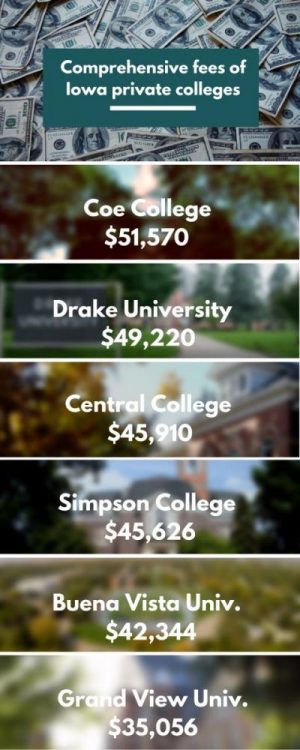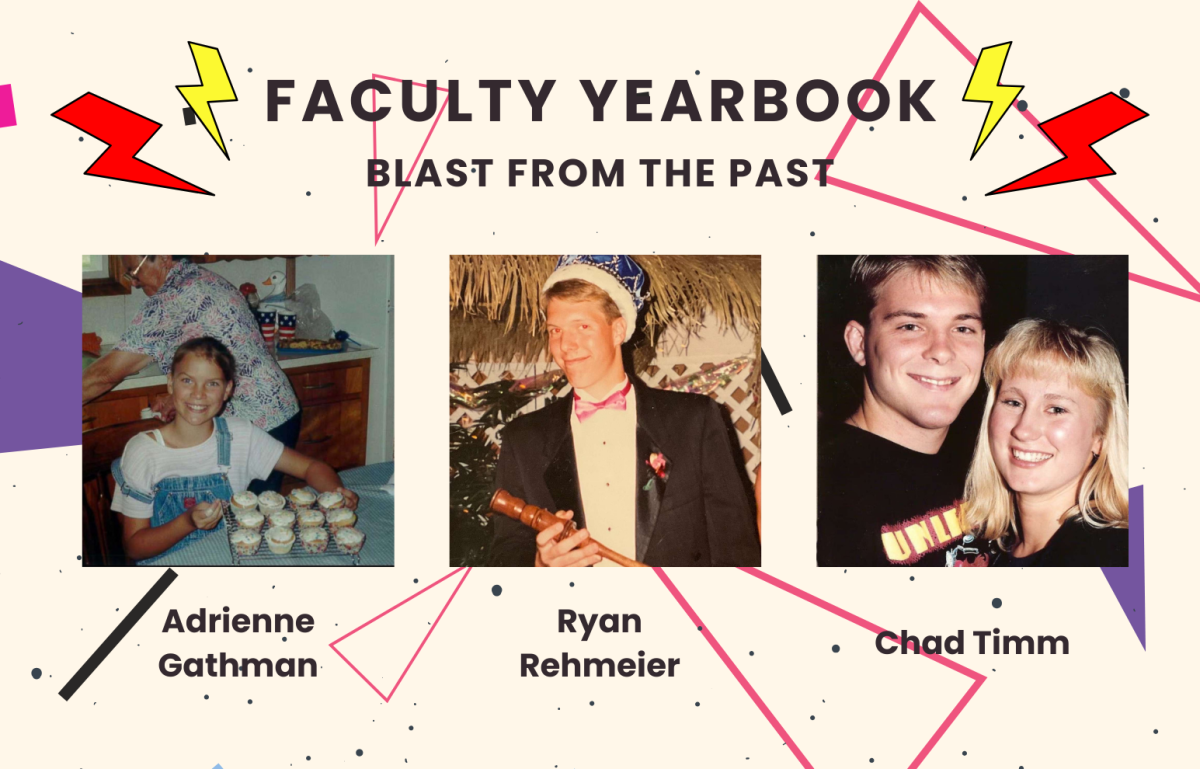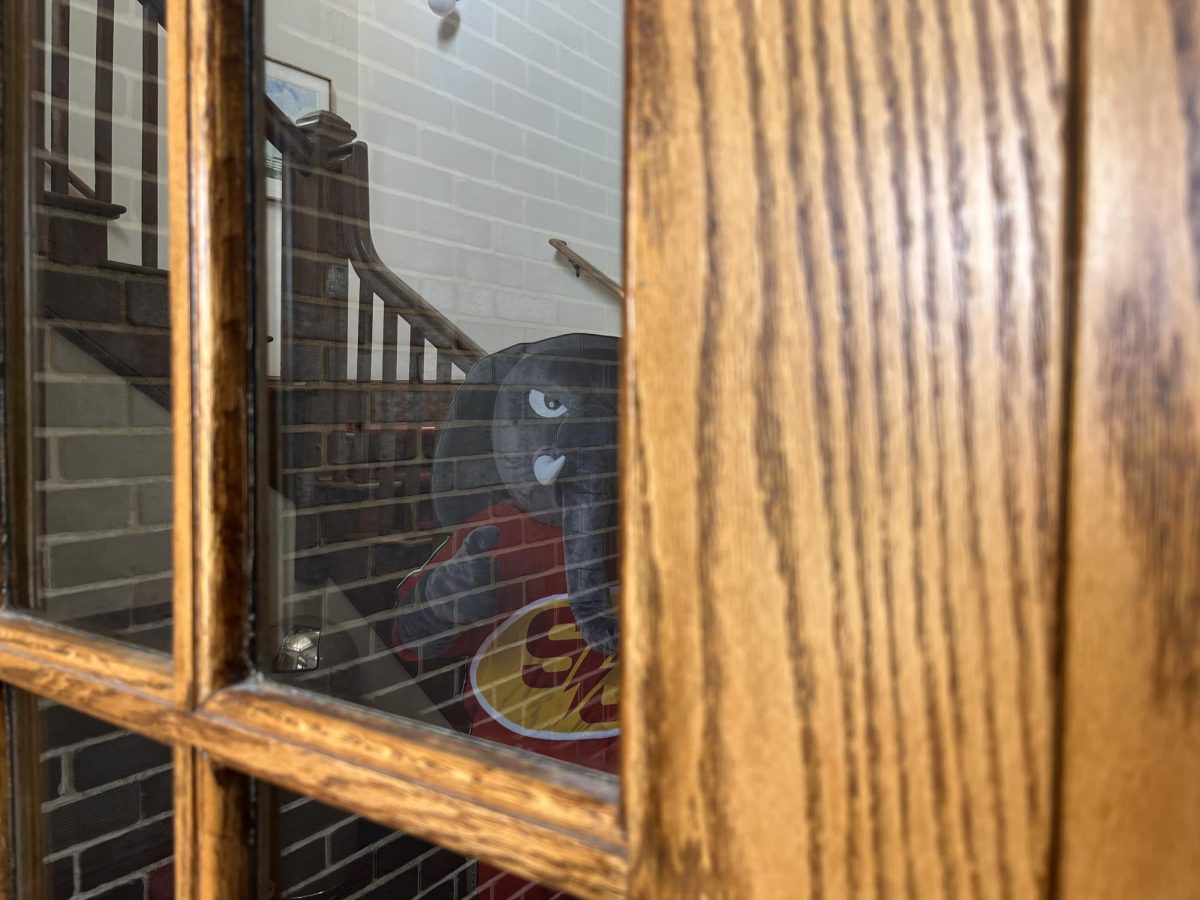Go big or go home: Private colleges fight waning enrollment
September 20, 2017
This article was prepared by the Simpsonian’s Jetstream Team, consisting of Alex Kirkpatrick, Emily Carey, Randy Paulson and Austin Hronich.
INDIANOLA, Iowa — With a shrinking number of Iowans seeking higher educations, private institutions such as Simpson College find themselves in a dogfight for in-state students, many of whom are opting for less expensive alternatives.
That’s one reason that Simpson and most of the nearly two dozen private colleges and universities are facing belt-tightening and reviews of their programs for students.
“Demographics are changing not only in Iowa, but states surrounding Iowa where we do most of our recruitment,” said Jill Johnson, vice president for marketing and public relations at Simpson College. “The competition is stiff, and we’re all competing for a shrinking slice of the pie.”
It doesn’t help that Iowa’s changing demographics are adding rugged challenges to the competitive landscape of higher education.
Data from the Iowa Department of Education indicate that the number of high school graduates and traditional-age college students will decline as Iowa’s population grows older. School-age children only make up 17 percent of Iowa’s population, and it’s projected to grow at a slow rate.
With a total comprehensive fee of $45,626 at Simpson, many prospective students — and their parents — are in sticker shock and won’t even consider looking at private institutions, said Dave Williams, assistant director of admissions at Simpson College.
Though he didn’t provide exact numbers, Williams estimated there are about 50 fewer freshmen and transfer students this year than last year’s incoming class of about 400 students.
“I think there’s a price sensitivity. It’s a big thing,” Williams said in a phone interview as he was traveling between fairs recruiting prospective students in Texas. “I think a lot of people rule out private schools because they have always heard that private schools are more expensive.”
The fact that most Simpson students and those at most private colleges pay deeply discounted costs doesn’t register with many families shopping for schools, Simpson officials said, and it’s hard for recruiters to get that message out when many Iowans won’t even look into private options.
National statistics are astonishing: College tuition has skyrocketed more than 500 percent since 1985, according to the Bureau of Labor Statistics, and student loan debt recently reached more than $1.45 trillion, surpassing all other forms of consumer debt, according to Student Loan Hero.
Simpson College’s board of trustees voted unanimously in December 2016 to approve a 4.1 percent increase in the comprehensive fee for the academic year that just began, boasting that it’s the sixth straight year to have not increased the cost of room and board.
But the college of more than 1,200 full-time students remains in the middle of the pack when it comes to other Iowa private colleges’ comprehensive fees. Here’s a look at overall prices, according to each institution’s website:
- Coe College – $51,570
- Luther College – $49,990
- Wartburg College – $49,478
- Drake University – $49,220
- Central College – $45,910
- Simpson College – $45,626
- Buena Vista University – $42,344
- Graceland University – $36,290
- Grand View University – $35,056
Even though it’s one of the most expensive colleges in Iowa, Coe College welcomed its largest incoming class this fall with 446 full-time students.
Administrators told Cedar Rapids television station KCRG they believe spending $24 million on several major facility projects, including the Coe College Athletics and Recreation Complex and the Center for Creativity and Careers, paid off. In addition, the college added a social and criminal justice major.
SIMPSON’S SECRET WEAPON
Simpson’s speech and debate program, as well as the John C. Culver Public Policy Center, both of which deal heavily with politics, have reported a surge in interest from the Class of 2021.
Iowa’s first-in-the-nation caucuses draw numerous politicians and presidential contenders to the Hawkeye State. As a result, those who study policy and public affairs benefit from the politically charged atmosphere, including Simpson.
The speech and debate program, headed by Spencer Waugh, has become a particularly effective recruiting tool for the college.
This past year alone, the program has reached out to nearly 1,000 prospective students from across the country, Waugh said. Out of the current freshmen class, Waugh said speech and debate had contact with 73 students.
As Simpson’s speech and debate program has seen more success in recent years, especially at national tournaments, more out-of-state prospective students have shown interest in joining the program, Waugh said.
The team sponsors a portion of the national high school speech and debate tournament, which is a recruitment strategy that Waugh said “has put Simpson on the map for students who otherwise wouldn’t have heard of us.”
In this year’s freshman class, Waugh said there are students from Colorado, Florida and Texas whom he first contacted at the national high school tournament.
Waugh also visits high schools and speak with debate teams or English and social studies classes. During these visits, Waugh brings Simpson speech and debate merchandise to give away, such as T-shirts.
While the speech and debate program does not have a quota for new recruits, Waugh said it has made steady gains in recent years.
“We’ve been increasing about 5-10 percent each year pretty regularly,” Waugh said.
It is difficult to know exactly how many students choose Simpson specifically for the speech and debate program since there are other factors these students consider in deciding on a college. For example, Waugh said some students want to participate in speech and debate, in addition to programs like music and theater.
However, he said there are currently 33 students with a scholarship for being on the speech and debate team, which “is a better number than the 73” for gauging their level of interest in the program. At two weeks in, he said about 50 freshmen have been regularly attending the team meetings, though he acknowledged that number is not likely to be sustainable throughout the year.
The Culver Center, a hub for politics at Simpson, has also become a major focus of recruitment for the college.
“The program size has grown over time,” said Seth Andersen, director of the Culver Center.
Starting in fall 2010, the Culver Center has grown in membership from only a few Culver Fellows being admitted in the first few years, to 14 and 13 incoming freshmen in 2016 and 2017, respectively.
“We’ve essentially, over time, doubled and then tripled the original size of the program in terms of the number of fellowships awarded,” Andersen said.
To market the Culver Center to prospective students, the Culver Center sends out packages of information materials via mail and email, as well as through social media. The center also works alongside admissions counselors to reach out to high school students who express interest in pre-law, political science and international studies.
Andersen said the center has a “network of Simpson alumni who are teaching around the Midwest to help identify students” who would be good fits for the program. Usually such alumni are government or history teachers, or speech and debate coaches.
Andersen also makes recruiting visits to schools in Iowa and other parts of the country in which Simpson has found a market, such as Washington D.C., Chicago and southwestern states such as Arizona, Colorado and Texas.
“It’s a lot of different methods, and then it’s a lot of scanning media and scanning social media,” Andersen said. “Any pick-ups that we get on students that are really active and engaged in politics.”
While the total number of Culver Fellows has been on the rise relative to past years, Andersen said there was a slight dip in the number of applications for the fellowship.
“For 2016, we received 35 completed applications for the Culver Fellowship,” he said. In 2017, that number was closer to 30.
TAKING ON HEAVYWEIGHTS
A statewide trend shows that parents are steering their children toward less expensive state universities, Williams said, because “they have a negative look or thought process on picking up student loans.”
Williams also blamed significant changes in federal rules for the Free Application for Federal Student Aid filings, which moved the financial aid form deadline back from Jan. 1 to Oct. 1 in an effort to make the financial aid process coincide with the college admissions cycle.
Students had to use earlier income and tax information on their FAFSAs. As a result, they received their award information earlier in the year, giving them more time to decide which school to attend.
Even though the state reached a record high school graduation rate of 91.3 percent in 2017 — a positive trend since 2011, according to data from the Iowa Department of Education — college-bound teenagers are flocking to state universities, especially after a 2014 campaign by the state Board of Regents to recruit in-state students. The University of Iowa alone spent an estimated $60 million over the past several years to dramatically increase its enrollment.
The University of Iowa, Iowa State University and the University of Northern Iowa have reported record enrollment since announcing the initiative.
The numbers of students enrolling at public universities has begun to taper off. The three state schools reported stagnant or slightly declining numbers of total enrollment this year after they expressed an interest to focus on quality over quantity — and financial support from the state diminished:
- Iowa State University – 36,321 students in 2017, compared with 36,660 in 2016
- University of Iowa – 33,564 students in 2017, compared with 33,334 in 2016
- University of Northern Iowa – 11,907 students in 2017 compared with 11,905 in 2016
That could potentially give private institutions an opportunity to capture the attentions of high school juniors and seniors as they decide where to get higher education, said Jay Simmons, president of Simpson College.
“It’s absolutely crystal clear from the data: Students who graduate from a place like Simpson have, by far, the greatest lifetime earnings because they’re the ones who wind up getting the promotions the soonest in their organizations and moving into the top leadership positions in their organizations,” Simmons said.
Simpson College junior Mason Burkhart, of Woodward, was on the verge of transferring after he withdrew from the football program because of health reasons. Fresh out of high school, Burkhart said athletics was a main reason for choosing Simpson.
“The landscape between high school football and college football is very different, and some people just don’t adapt to that change or find that it’s not for them,” Burkhart said of his football teammates who have since dropped out of college.
Burkhart said he stayed because he couldn’t find a better alternative.
Former student Daniel Halstead, 19, of Des Moines, transferred to Des Moines Area Community College in Ankeny after one semester because Simpson College didn’t offer his area of interest.
Intending to go into business, Halstead instead decided that a career in auto-collision repair would better suit him after he spent most of his weekends during his first semester at college working on his car.
“Cars are my passion, something I’ve always wanted to do,” Halstead said. “I’m always on the go, always trying to do something. … I wake up every day and I want to go to school. I want to work on cars. I want to get better.”
Simmons also said that many prospective students are stepping out of college altogether because “the strength of the economy right now is so good.”
“Iowa is the state with the biggest decline in overall participation in higher education of any state in the union in percentage terms,” Simmons said. “We’re feeling it, in some ways, more acutely than anybody else.”
A report from Deloitte Consulting LLP and the Manufacturing Institute estimated that nearly 3.5 million manufacturing jobs will likely need to be filled over the next decade, signifying a significant skills gap. This comes after decades of pushing for academic degrees right after high school instead of training in industrial and other trades.
And there are 30 million U.S. workers who have median earnings of $55,000 without having a bachelor’s degree, according to the Georgetown University’s Center on Education and the Workforce.
KEEPING UP WITH COMPETITION
Institutions such as Simpson College won’t be going away anytime soon. The college generated $47.4 million from tuition in 2015 alone, according to an Internal Revenue Service Form 990 report filed in July 2017.
While the college is struggling with balancing its operations budget, it does have an endowment of nearly $80 million, according to U.S. News and World Report’s latest college rankings.
College officials said the challenge is in balancing its budget while keeping its endowment intact.
“When it comes to overall financial strength, Simpson College is in great shape,” Simmons said. “We have a budget issue, not an overall financial issue. We have very little debt.”
Simmons also said the overall composite financial index scores, a standard way of measuring the relative financial health of an institution and its financial responsibility compliance, are very high.
“You know, people say (enrollment) is super low, and it’s actually not,” he said. “Yes, we’re smaller than we’ve been the last few years, but historically we’re actually much closer to our norm.”
“Simpson College has been here since 1860, so that’s 157 years. We’re going to be here for at least another 157 years,” Simmons said.
A panel of administrators participated in a Q&A last Wednesday to clarify rumors swirling around campus concerning budget issues.
To make up for the smaller freshman class size, administrators elected to implement furlough days, or a temporary leave of absence from work, for this academic year.
The number of furlough days is based on an employee’s salary level, ranging from one to five furlough days.
“We’re trying to make sure they happen at a time when students feel it the least,” Simmons said. “Hopefully they won’t feel it at all.”
Officials didn’t give a specific deadline, but a program review will take place during the academic year with a plan to publish a report next fall and a similar report for student organizations in the spring.
The admissions office has to think outside the box — and outside the state — if they want to successfully deal with what Williams called the sheer competitiveness of higher education in Iowa.
“You have 29 different schools in a small state like Iowa,” he said. “We have to go out of state if we want to continue to see the numbers where they need to be.”
Williams’ pitch to out-of-state prospective students is an individualized approach designed to attract them to specific programs at Simpson, such as speech and debate or theater.
“I think it’s always going to be a struggle unless you truly are a brand-name school,” Williams said. “I think we sell ourselves short on a lot of things that we do on campus.”
The Simpsonian’s Matt Lash contributed to this article.
___
The Simpsonian’s Jetstream Team consists of four reporters and staff members dedicated to in-depth and investigative reporting on Simpson College’s campus and student-related subjects.
If you have a tip, please contact these representatives of Jetstream:
Alex Kirkpatrick, Jetstream Editor
Alex is a senior majoring in multimedia journalism and minoring in French.
Email: alex.kirkpatrick@my.simpson.edu
Emily Carey, Digital Media Manager
Emily is a junior majoring in multimedia journalism and theater.
Email: emily.carey@my.simpson.edu
Randy Paulson, Senior Staff Reporter
Randy is a junior majoring in multimedia journalism and minoring in Spanish.
Email: randy.paulson@my.simpson.edu
Austin Hronich, Director of Photography
Austin is a junior majoring in sports communication.
Email: austin.hronich@my.simpson.edu






